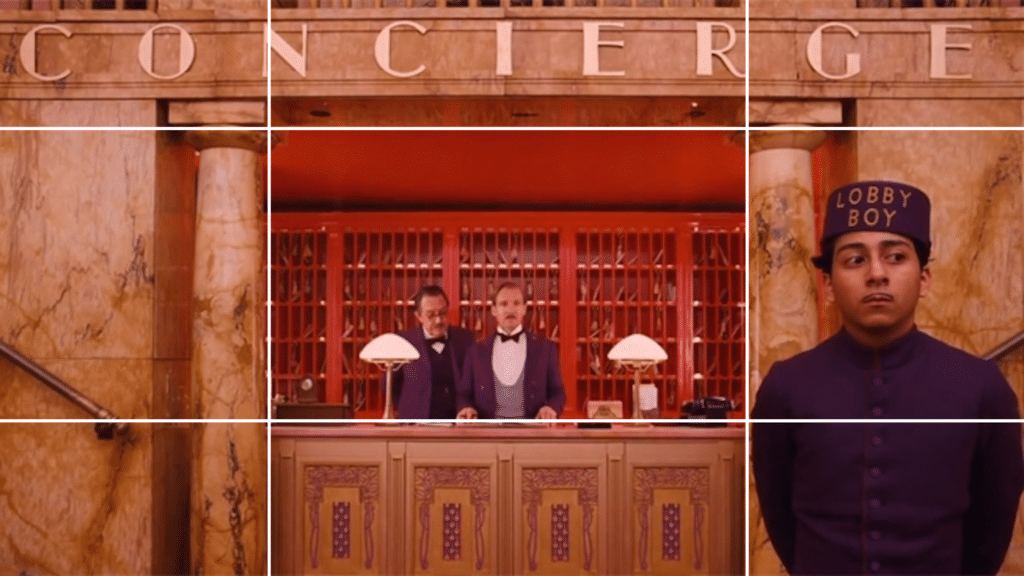
Visual storytelling is more than what’s just in the frame, but about how it’s framed.
Leading lines are one of the most powerful yet often subconscious tools in the visual storyteller’s toolbox! They guide the viewer’s gaze, emphasize story elements, and trigger emotional responses.
While you may think leading lines in film are for those holding the camera, you’d be wrong. Everyone from storyboard artists to screenwriters should understand the impact of leading lines and how they can elevate storytelling to another level.
That’s where we come in! In today’s blog, we’ll be exploring what leading lines are, why they matter, how they’ve been used in iconic films, plus how you can integrate them into your own work, whether you’re a photographer, cinematographer, director, or writer.
Lights, camera, action!
Table of Contents
- What Are Leading Lines?
- How Leading Lines Guide the Viewer’s Eye
- Examples of Leading Lines in Film
- How to Use Leading Lines in Storyboarding & Shot Composition
- Photography vs. Cinematography: How Leading Lines Differ
- Best Practices for Using Leading Lines in Your Own Work
- Conclusion
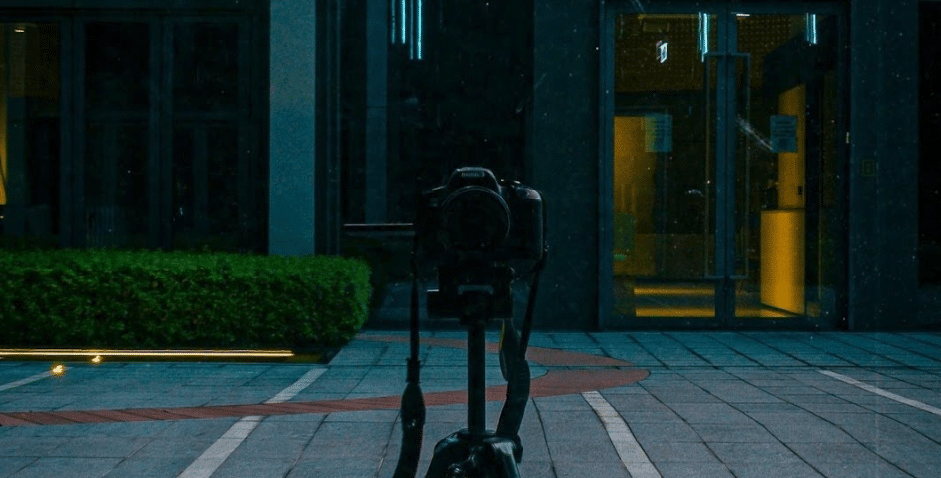
What Are Leading Lines?
First and foremost, leading lines are visual elements in an image or film frame that draw the viewer’s eye towards a point of focus. This is usually the subject or a key part of the composition.
Leading lines can be literal, for example, hallways, fences and roads. Or they can be implied lines like light and shadow, movement and eye lines.
The key term here is ‘leading’ as the lines guide our attention to a particular focus on screen.
So, why should you use leading frames? Well, they:
- Create depth and perspective.
- Emphasize key narrative elements.
- Add movement or direction to a still frame.
- Enhance mood and tone.
Leading lines change what is just an image, to a visual journey that viewers can take. They help tell the story and are one of the key film framing techniques a filmmaker can use.
How Leading Lines Guide the Viewer’s Eye
Let’s take a closer look at how leading lines spark a conversation between the image and the audience. Remember, visual storytelling isn’t passive but active, drawing us into the action.
Leading lines guide the eye, not by telling, but by inviting us to look where they storyteller wants us to.
Yes, you got us! In short, it’s another way of saying ‘show don’t tell’. Here are three ways leading lines do just that:
1. Directs Attention
Whether it’s a soldier standing at the end of a corridor or a lone figure on a highway, lines that hone in on a single subject immediately draw our eye.
It’s a fantastic technique to use for highlighting characters in vast or chaotic scenes, like an epic battle.
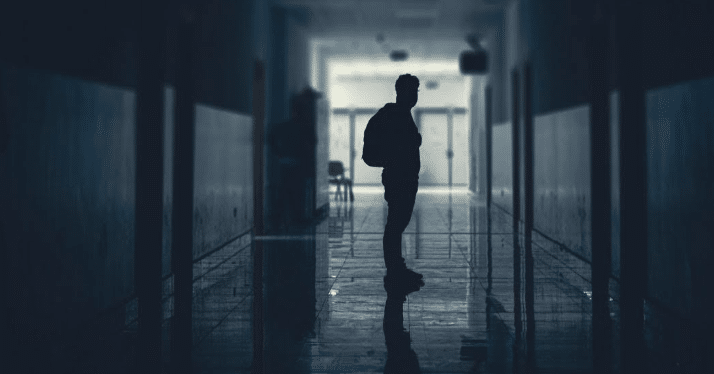
2. Creates Movement
Our eyes naturally follow lines, especially diagonals or curves, which creates movement within a still image. Our eyes are drawn from one part of the frame to another.
As filmmakers, we can use these to build pacing within a shot or subtly hint at an emotional shift in the story.
3. Conveys Emotion and Tone
Lines in different configurations can also suggest mood. For example, horizontal lines can evoke calm and stability, while vertical lines suggest power or rigidity. For diagonal lines, these often feel dynamic or unsettling.
If we use these lines intentionally, they can shape how a scene feels, not just how it looks.
Visuals tell your story just as much as words do. Celtx helps you shape both.
Try it for free today!
Examples of Leading Lines in Film
Many directors and cinematographers use leading lines so well that audiences don’t always notice off the bat. Instead, they feel them.
Let’s see the masters at work with some stellar leading lines examples:
Case Study #1 | The Shining (1980)
Director Stanley Kubrick used symmetry and straight-on shots constantly in The Shining to create an eerie tension all the way through.
The long hallways of the Overlook Hotel are key examples of leading lines, as they stretch endlessly, pulling viewers into the unknown and making them feel uneasy.
The famous tricycle scenes show young Danny centered in the frame. The straight hallway lines draw our attention to him, which also emphasizing his isolation and a sense of looming dread.
In this scene, Danny cycles through the empty hotel hallways before encountering the ghosts of the murdered Grady twins.
Case Study #2 | Mad Max: Fury Road (2015)
This film is the definition of chaos and velocity, and director George Miller somehow keeps the action visually coherent with his masterful composition.
Throughout the epic chases, Miller uses roads, tire tracks, and the horizon line to direct our eye towards the center of the action. Even in the most frantic of the chases, we’re never lost because the lines of the frames guide us effortlessly.
Case Study #3 | Blade Runner 2049 (2017)
The visuals brought Denis Villeneuve’s vision to life with leading lines in both the architecture of the city and natural settings.
Stark lines in the futuristic buildings draw attention to the human subjects dwarfed by technology, while the environmental elements like snow-covered streets or sand dunes guide us through desolate landscapes.
What results is a world that feels immense, but is meticulously controlled, allowing us to focus on what’s important to the story.
In this scene when K (Ryan Gosling) travels through the city for his baseline test, we’re guided through with the use of stark leading lines, allowing us to focus on his journey through the big city.
Case Study #4 | Inception (2010)
Leading lines are a subtle but consistent part of the visual language of Inception. Christopher Nolan’s vision of the dreamscapes uses architectural elements such as staircases, corridors and bridges to lead out eye towards key moments of action or revelation.
In the hallway fight scene, the hallway itself rotates, the corridor becoming both a literal and metaphorical line of vision for the audience. The camera spins, causing the lines to disorient and reorient the viewer.
Here we see the themes of shifting reality and unstable perception be physically manifested in the frame, drawing us in even more.
Case Study #5 | 2001: A Space Odyssey (1968)
Another Stanley Kubrick example! In 2001: A Space Odyssey, he uses leading lines to keep us focused on the key elements in the vast depths of space.
As the flight attendant makes her way around, while we see the enormity of the spacecraft she’s in and its technological advancements, our eyes are constantly on the attendant, our attention on her journey.
How to Use Leading Lines in Storyboarding & Shot Composition
Leading lines aren’t for post-production but should be considered from the early stages of visual planning.
So, how can you make the most of leading lines throughout the pre-production process?
1. Plan Your Perspective
Choose angles that naturally create depth in your shot. For example, low angles looking up at a skyscraper or a wide-angle shot down a hallway both create strong converging lines.
This can be planned in the storyboarding process: start by sketching where the lines will fall in your frame and build your composition around them.
Celtx’s storyboarding tools are perfect to help you plan each and every shot! Find out how we can help here.
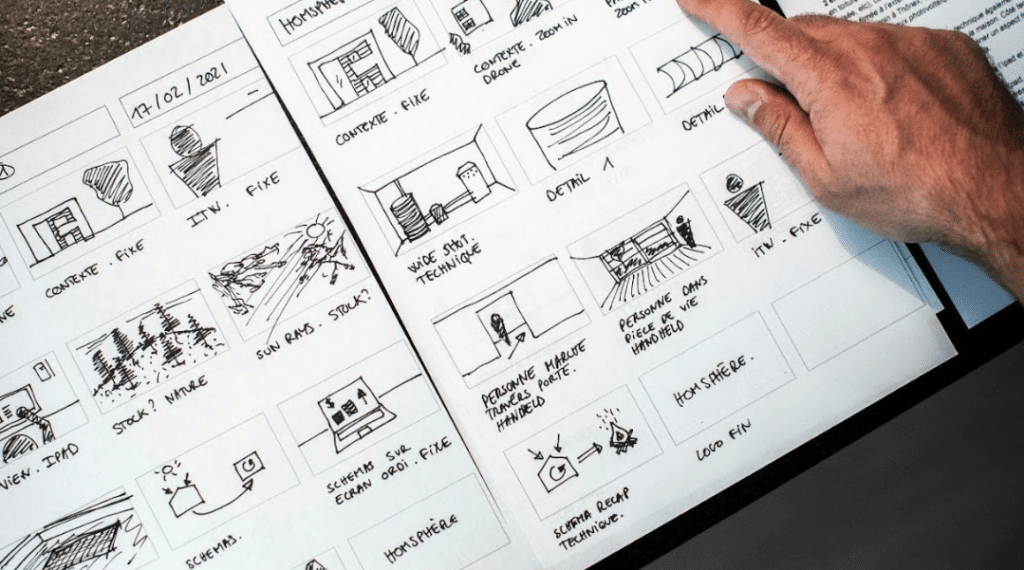
2. Use the Environment Strategically
Stairs, doorways, paths, fences and bridges are all naturally occurring leading lines. Think of the environment as a character in itself that can help express emotion or intention through its leading lines. Use this to your advantage.
3. Combine Lines with Other Elements
Leading lines don’t need to work alone and can be integrated with other elements in the shot. Everything from color contrast, lighting, to character placement can enhance the effectiveness of leading lines.
For example, if you have a character at the center of converging lines who is dramatically lit, you can instantly create a powerful image that audiences will remember.
Photography vs. Cinematography: How Leading Lines Differ
You’d be right in thinking that the concept and practice of leading lines originated from photography. With the emergence of film, they became a cinematographer’s bread and butter.
Both mediums offer their own possibilities and challenges. Let’s take a look at each.
In Photography
- All images are static, meaning the viewer’s eye moves, but the frame doesn’t.
- Composition is key and the power of leading lines must be captured in a single, determined moment.
- There are no sequences to rely on, with all of the emotion and direction of the shot living in a single frame.

In Cinematography
- Filmmakers can take advantage of movement, both of the camera and within the frame itself.
- Leading lines can evolve over time or change meaning during a scene.
- The dynamic relationship between frames allows for rhythm and pacing.
While there are some stark differences between the use of leading lines in photography and cinematography, the principles remain the same. Leading lines are the silent narrator!
For screenwriters and directors, we can study photography to sharpen our visual intuition and help us visualize our scenes as we write or plan.
There’s a lot to be learned from considering how photographers use light, architecture, and nature to shape a single frame. If we can translate this into our movies, there is so much opportunity for us to deepen our storytelling skills.
Plan your shots, set your angles, and keep your visuals strong from script to screen with Celtx script writing and pre-production software.
Start your free trial today
Best Practices for Using Leading Lines in Your Own Work
Think you’re ready to start incorporating leading lines into your next script or movie? Let’s explore how we can use leading lines effectively and make the best of them to create kickass shots!
1. Be Intentional
There’s nothing worse than relying on luck or accident when it comes to planning your shots. Plan your compositions so that the lines in your environment support your narrative.
Ask yourself the question: What do I want the audience to look at, and how can the environment help me to show that?
2. Avoid Overcrowding
Too many lines going in multiple directions can confuse the eye. Simplify the frame by choosing one to two dominant lines and ensure they support the story.
The cleaner and more uncluttered the shot, the more impact they’ll have on the audience.
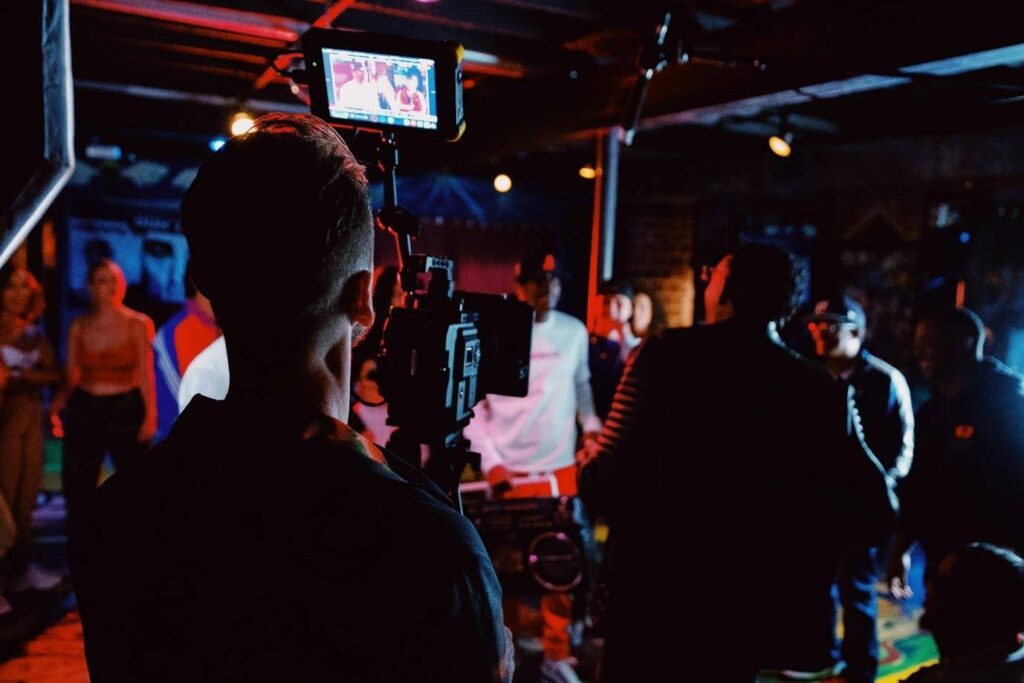
3. Think About Emotional Impact
Consider what kind of feeling you want the shot to convey in that moment. For example, if you choose diagonal lines, it evokes urgency or danger, while curved lines could suggest gentleness or ambiguity.
In short, line direction and strength support the emotional arc of the scene so needs to be well thought out.
4. Use Depth to Your Advantage
Leading lines are a fantastic way to create a sense of three-dimensionality in a two-dimensional image. If you can draw the viewer’s eye into the scene, you make the space feel immersive and alive!
5. Break the Rules
…but only when it serves the story!
Once you’re comfortable using leading lines, try turning expectations on their head. You can use lines instead, to misdirect, create tension or emphasize chaos.
Leading lines don’t always have to lead to a subject but can lead away from one too, to show distance, longing or even loss.
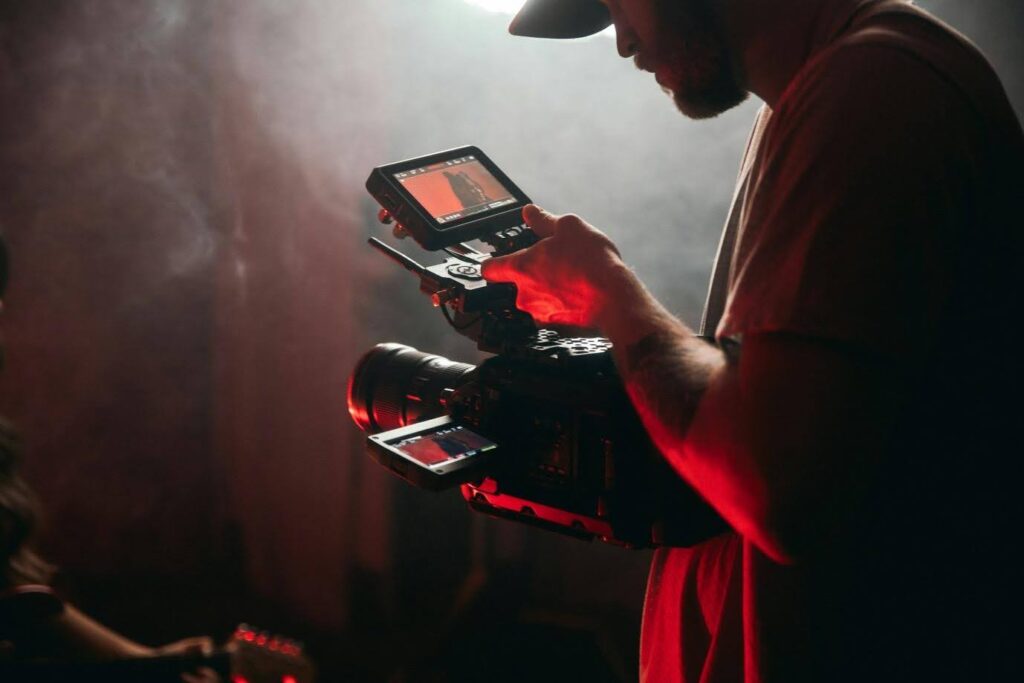
Conclusion
Leading lines are more than just a compositional trick—they are a foundational element of visual storytelling. Whether you’re capturing a moment with a camera, planning a shot on a storyboard, or writing a visually driven scene in a screenplay, understanding how leading lines function can drastically improve how your story is received and remembered.
They give your visuals direction, power, and meaning which quietly guide the audience’s gaze and emotions without a single line of dialogue.
So next time you’re composing a shot or writing a scene, ask yourself: Where are the lines—and where are they leading?

Enjoyed this article? Try these next:
- What is a Cinematographer, and What Do They Do?
- A-Roll vs. B-Roll Footage | What’s the Difference?
- Celtx: Your Ultimate Tool for Creating an Efficient Shot List
